NRCS uses a win-win approach to systematically target conservation efforts to improve agricultural and forest productivity which enhance wildlife habitat on working landscapes.
Agriculture and wildlife both thrive together through landscape-scale conservation. Two-thirds of the land in the lower 48 States is privately owned, and these productive working farms, ranches and forests provide critical ecosystems for wildlife as well as the food and fiber that sustains us all.
From critical migratory areas for waterfowl to nectar-rich plantings for pollinators, many species have rebounded and recovered largely because of the conservation work by producers on private lands. NRCS uses a science-based, targeted approach to guide producers on how to best manage ecosystems to maximize beneficial outcomes, both for wildlife and agricultural operations.
Insects and Pollinators
Three-fourths of the world’s flowering plants and about 35 percent of the world’s food crops depend on animal pollinators to reproduce. More than 3,500 species of native bees help increase crop yields. Some scientists estimate that one out of every three bites of food we eat exists because of animal pollinators like bees, butterflies and moths, birds and bats, and beetles and other insects.
Pollinators visit flowers in their search for food (nectar and pollen). During a flower visit, a pollinator may accidentally brush against the flower’s reproductive parts, unknowingly depositing pollen from a different flower. The plant then uses the pollen to produce a fruit or seed. Many plants cannot reproduce without pollen carried to them by foraging pollinators.
NRCS is working with agricultural producers to combat future declines of insects and pollinators by helping them to implement conservation practices that provide forage while enhancing habitat and improving the quality of water, air and soil.
Honey Bees
The U.S. Department of Agriculture (USDA) has programs to help honey producers every step of the way — from plants to the final product. We have programs to help protect and conserve habitat, protect your investments and recover from disasters impacting your operation.
Monarch Butterfly
Monarch populations have decreased significantly over the past two decades, in part because of the decrease in native plants, including milkweed, on which their caterpillars feed. Agriculture and development have removed much of the native milkweed that once spanned the country.
Upland and Aquatic Wildlife
Perhaps the greatest threat to wildlife is habitat loss through lack of management, invasive plants and habitat conversion or destruction. Upland and wetland habitat dependent organisms that lack adequate tree, shrub or herbaceous plant cover necessary for nesting, shelter, feeding and resting will not thrive. Quality aquatic habitat includes multiple structural features within and adjacent to the water body; water in enough quantity and quality to sustain native organisms; and access to upstream and downstream habitats. Maintaining or increasing terrestrial and aquatic habitat is critical to sustaining long-term population stability. Conserving, restoring and connecting habitat improves the odds that wildlife communities will thrive.
Working Lands for Wildlife
Through the Farm Bill, NRCS provides technical and financial assistance to participants who voluntarily make improvements to their working lands using the Working Lands for Wildlife (WLFW) framework. USDA uses this win-win approach to systematically target conservation efforts to improve agricultural and forest productivity which enhance wildlife habitat on working landscapes. Target species are used as barometers for success because their habitat needs are representative of healthy, functioning ecosystems where conservation efforts benefit a much broader suite of species.
Targeted Species in Indiana
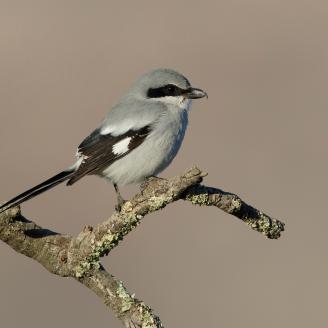
Grassland Birds
Grasslands are declining throughout the United States, which is causing a decrease in the populations of grassland gamebirds and songbirds including the Northern bobwhite, Henslow’s sparrows, Loggerhead shrike, Ring-necked pheasants and other grassland species. These species play an important role in the ecosystem as pollinators and as recreational attractions for bird watching and/or hunting.
Indiana NRCS has partnered with the Indiana State Department of Natural Resources, Natural Resources Foundation, non-profit conservation groups, private industries and other sponsors to develop the Grasslands for Gamebirds and Songbirds Initiative to restore grassland habitats through the state to benefit birds and other pollinator species. The public/private GGS initiative works to restore grassland habitat in order to:
- Develop and improve grasslands and pollinator habitats in targeted areas in Indiana.
- Improve soil health and water quality.
- Improve species diversity.
- Increase hunting, birding and outdoor recreation opportunities.
- Improve overall human health.
- Increase funding to local economies.
- Preserve cultural heritage.
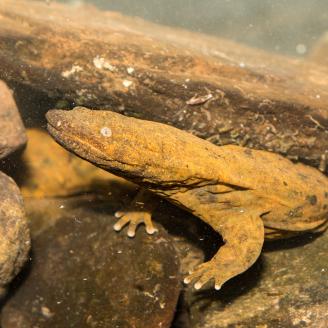
Eastern Hellbender
The Eastern hellbender (Cryptobranchus alleganiensis) sometimes referred to as “mud devil”, “devil dog” or “ground puppy” is the largest salamander in the United States with some reaching a weight of more than two pounds and extending an impressive length of two feet (average around 17 inches). Once common in the eastern United States, the species has faced population decline due to inadequate habitat and water quality degradation. Like many other amphibians, these fully-aquatic salamanders are vulnerable to environmental disturbance that impacts breeding.
Indiana NRCS has partnered with Purdue University's Helping the Hellbender project and 13 other conservation and agriculture organizations to launch the The Farmers Helping Hellbenders Initiative through the Regional Conservation Partnership Program. The initiative will address the recovery of the Eastern Hellbenders and improvement of aquatic resources in the Blue River watershed by increasing enrollment in agricultural conservation practices.
The initiative will target agricultural lands in Washington, Harrison, Crawford, and Floyd Counties, the only remaining area in Indiana where the Eastern Hellbender can be found and is currently being actively managed.
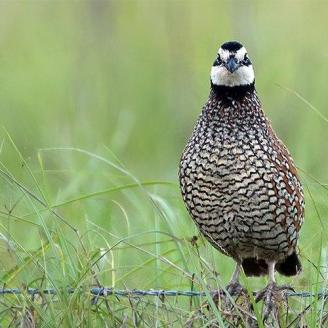
Northern Bobwhite Quail
The northern bobwhite (Colinus virginianus) is often referred to as an “edge” species, seeking habitat where crop fields intersect with woodlands, pastures and old fields. Historically, land use favored bobwhite, but changes in land use and how lands are managed have caused the bird’s numbers to dip by more than 80 percent over the last 60 years.
Landowners in 25 states including Indiana are helping the bobwhite by managing for early successional habitat on working lands. With the help of NRCS, landowners are making wildlife improvements to working lands, such as establishing field borders and buffer strips, integrating native plants into conservation cover and pasture plantings, and thinning mature forests through brush management and prescribed fire to invigorate understory vegetation.
Through the Working Lands for Wildlife (WLFW) partnership, a collaborative approach to conserve habitat on working lands, NRCS has developed a multi-state, areawide planning initiative with the first biome-scale framework for wildlife conservation in the working lands within the 25-states of the northern bobwhite framework.
NRCS offers technical and financial assistance to help landowners manage for early successional habitat. This assistance helps producers plan and implement a variety of conservation activities, or practices, that benefit the bobwhite and many other game and non-game species.
Find out more information about how WLFW can help you build habitat for the northern bobwhite.
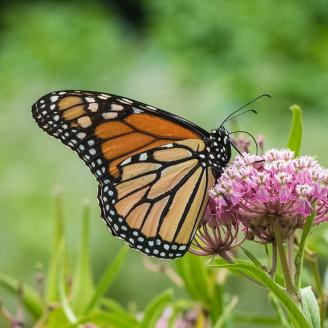
Monarch Butterfly
The monarch butterfly is one of the most iconic butterflies in North America and is known in part for its annual multi-generational migration from overwintering sites in central Mexico and coastal California to as far north as Canada. Multiple critical population stressors including the loss and degradation of habitat across the species' range have led to a significant decrease in the number of monarchs in the U.S. over the past few decades.
NRCS is working with America's farmers, ranchers and forest managers on voluntary conservation efforts to combat the decline of monarchs on private lands by establishing new habitat including milkweed and other nectar-rich plants and managing existing habitat for monarchs and pollinators.
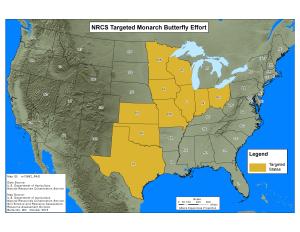
NRCS offers technical and financial assistance to help landowners manage for monarch habitat on farms, ranches and forests. This assistance helps producers plan and implement a variety of conservation activities, or practices, that benefit the monarch, pollinators and many other wildlife species.
Monarchs are a nationally identified target species of the Working Lands for Wildlife (WLFW) partnership, a collaborative approach to conserve habitat on working lands. NRCS collaborated with the U.S. Fish and Wildlife Service, enabling the species to be added to the effort in 2017.
Through WLFW, NRCS targets conservation efforts where the returns are highest by targeting the threat of habitat loss. WLFW is able to provide technical and financial assistance through the Environmental Quality Incentives Program, Agricultural Conservation Easement Program and Conservation Stewardship Program, three programs funded through the Farm Bill, the largest funding source for wildlife habitat conservation on private lands.
Learn more about NRCS's monarch conservation efforts and see what assistance is available.
Common Indiana Wildlife Practices
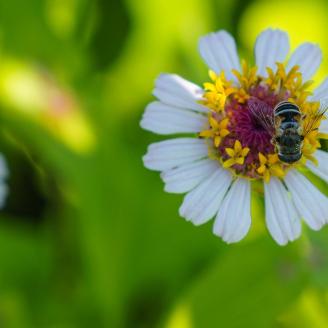
Wildlife Habitat Planting
This practice is used to accomplish improve degraded wildlife habitat for the target wildlife species or guild, or establish wildlife habitat with herbaceous vegetation that resembles the historic, desired, and reference native plant community. This practice is used to accomplish improve degraded wildlife habitat for the target wildlife species or guild, or establish wildlife habitat with herbaceous vegetation that resembles the historic, desired, and reference native plant community.
Benefits include:
- Improve degraded wildlife habitat for the target wildlife species or guild
- Establish wildlife habitat that resembles the historic, desired, and reference native plant community
Planting at the proper seeding rate is an important step to ensure a successful native warm-season grass and forb planting or a wildlife food plot. This video will discuss how to properly calibrate the seeding rate for a Truax No-Till Seed Drill. The video will also discuss a calibration method that can be used with multiple different types of seed drills.
The full practice standard can be found on the Indiana NRCS FOTG site.
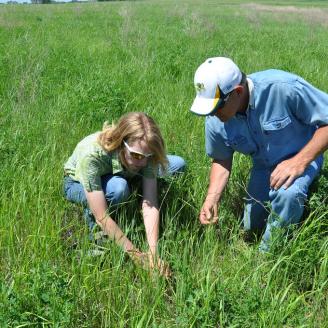
Early Successional Habitat Management
Manage plant succession to develop and maintain early successional habitat to benefit desired wildlife and/or natural communities.
Benefits include:
- Providing habitat for species requiring early successional habitat for all or part of their life cycle
For more information about planting desirable native grasses and forbs to develop wildlife habitat please utilize Purdue's Renovating native warm-season grass stands for wildlife publication. This publication describes management practices and common problems faced by land managers who use native warm-season grass stands for wildlife.
The full practice standard can be found on the Indiana NRCS FOTG site.

Hedgerow Plantings
Using dense vegetation, primarily shrubs and bunch grasses, in a linear design to provide food, cover and corridors for wildlife.
Benefits include:
- Habitat, including food, cover, and corridors for terrestrial wildlife
- Enhancing pollen, nectar, and nesting habitat for pollinators
- Food, cover, and shade for aquatic organisms that live in adjacent streams or watercourses
- Providing substrate for predaceous and beneficial invertebrates as a component of integrated pest management
- Intercepting airborne particulate matter
- Reducing chemical drift and odor movement
- Screens and barriers to noise and dust
- Increasing carbon storage in biomass and soils
- Living fences
- Boundary delineation and contour guidelines
The full practice standard can be found on the Indiana NRCS FOTG site.
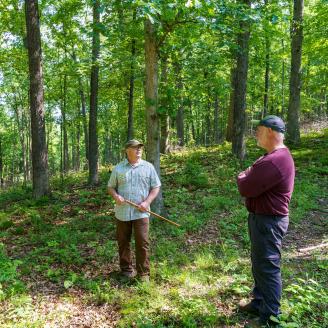
Invasive Species Control
Invasive species control is available to Indiana producers through either the brush management practice or herbaceous weed control. Both practices are available through the Environmental Quality Incentives Program. Indiana NRCS has partnered with the State of Indiana Cooperative Invasives Management (SICIM) program to develop local Cooperative Invasive Species Management Areas (CISMAs) through the Indiana Invasives Initiative to help producers combat invasive species.
Brush Management:
Brush management techniques can be used in forestland to help landowners control invasive woody species problems such as bush honeysuckle, autumn olive, and multiflora rose. Woody invasive species are very prolific at seed production and sprouting, and are mostly shade tolerant. These characteristics give them a distinct advantage over native species and oftentimes, if not addressed completely, can take over and even replace native plants, trees and shrubs.
Benefits include:
- Removes competition so beneficial vegetation can re-establish.
- Creates desired plant community
- Improves wildlife habitat
- Enhances tree regeneration
- Increases tree growth and health
The Indiana Invasive Species Council has compiled a list of invasive species that are illegal to sell, gift, barter, exchange, distribute, transport, or introduce plants in the State of Indiana.
The full practice standard can be found on the Indiana NRCS FOTG site.
Herbaceous Weed Control:
The removal or control of herbaceous weeds including invasive, noxious, prohibited, or undesirable plants, for the purpose of restoring and releasing native or desired plant communities for wildlife habitat.
Benefits include:
- Enhance accessibility, quantity, and/or quality of forage and/or browse
- Restore or release native or desired plant communities for wildlife habitat
- Protect soils and control erosion
- Reduce fine fuel loads and wildfire hazard
- Control pervasive plant species to a desired level of treatment
The full practice standard can be found on the Indiana NRCS FOTG site.
Contact
Additional Information
Working Lands for Wildlife
Through Working Lands for Wildlife (WLFW), USDA uses a win-win approach to systematically target conservation efforts to improve agricultural and forest productivity which enhance wildlife habitat on working landscapes.
INDIANA PAYMENT SCHEDULES
NRCS provides financial assistance for selected conservation practices. The availability and amount of financial assistance can vary between states. Download the Indiana payment schedules from the link below to see which activities qualify, and how much financial assistance is available.
APPLICATIONS AND FORMS
If you’re interested in applying for NRCS conservation programs, contact your local NRCS office. To apply, you’ll have to complete an application as well as have other forms on file. To view examples of the form click the link below.
INDIANA NRCS HOMEPAGE
For more information about NRCS programs offered in Indiana and how experts throughout the state can help you address natural resource concerns on your land, visit the Indiana NRCS homepage.

